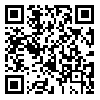Volume 20, Issue 4 (Winter 2026)
Salmand: Iranian Journal of Ageing 2026, 20(4): 624-639 |
Back to browse issues page
Download citation:
BibTeX | RIS | EndNote | Medlars | ProCite | Reference Manager | RefWorks
Send citation to:



BibTeX | RIS | EndNote | Medlars | ProCite | Reference Manager | RefWorks
Send citation to:
Zarmehri F J, Torkashvand Moradabadi M. A Study on Death Rate and Its Causes Among the Elderly Population in Iran From 1981 to 2021. Salmand: Iranian Journal of Ageing 2026; 20 (4) :624-639
URL: http://salmandj.uswr.ac.ir/article-1-3040-en.html
URL: http://salmandj.uswr.ac.ir/article-1-3040-en.html
1- Depertment of Demography, Faculty of Social Sciences, Yazd University, Yazd, Iran.
2- Depertment of Demography, Faculty of Social Sciences, Yazd University, Yazd, Iran. ,m.torkashvand@yazd.ac.ir
2- Depertment of Demography, Faculty of Social Sciences, Yazd University, Yazd, Iran. ,
Abstract: (1788 Views)
Objectives The number of older people is increasing worldwide, which is associated with a higher mortality rate. This study aims to determine the death rate and its causes among older people (aged 65 and above) in Iran from 1981 to 2021.
Methods & Materials This is a cross-sectional study employing secondary data analysis. The data were prepared from the 2021 global burden of disease study. Causes of death were classified based on the international classification of diseases (ICD-11), and mortality rates were used as comparative indices across gender and age groups.
Results Mortality rate among the elderly population increased from 69,000 deaths (19% of total mortality) in 1981 to 360,000 deaths (63.5% of total mortality) in 2021. The mortality rate was higher in men than in women, and over 90% of deaths were due to non-communicable diseases, especially cardiovascular diseases, cancer, diabetes, and neurological disorders.
Conclusion Non-communicable diseases contribute to a higher mortality rate among the elderly population in Iran. Prevention methods remain the most effective strategy for addressing these conditions. Achieving success in this field necessitates collaboration between the Ministry of Health and various social institutions across the country.
Methods & Materials This is a cross-sectional study employing secondary data analysis. The data were prepared from the 2021 global burden of disease study. Causes of death were classified based on the international classification of diseases (ICD-11), and mortality rates were used as comparative indices across gender and age groups.
Results Mortality rate among the elderly population increased from 69,000 deaths (19% of total mortality) in 1981 to 360,000 deaths (63.5% of total mortality) in 2021. The mortality rate was higher in men than in women, and over 90% of deaths were due to non-communicable diseases, especially cardiovascular diseases, cancer, diabetes, and neurological disorders.
Conclusion Non-communicable diseases contribute to a higher mortality rate among the elderly population in Iran. Prevention methods remain the most effective strategy for addressing these conditions. Achieving success in this field necessitates collaboration between the Ministry of Health and various social institutions across the country.
Type of Study: Research |
Subject:
Social
Received: 2025/03/22 | Accepted: 2024/12/30 | Published: 2026/03/01
Received: 2025/03/22 | Accepted: 2024/12/30 | Published: 2026/03/01
Send email to the article author
| Rights and permissions | |
 |
This work is licensed under a Creative Commons Attribution-NonCommercial 4.0 International License. |








